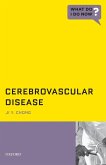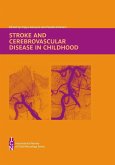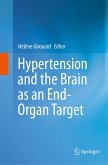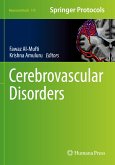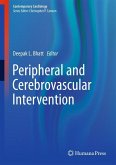Cerebrovascular Disease
22nd Princeton Conference
Herausgeber: Chan, Pak H.
Cerebrovascular Disease
22nd Princeton Conference
Herausgeber: Chan, Pak H.
- Broschiertes Buch
- Merkliste
- Auf die Merkliste
- Bewerten Bewerten
- Teilen
- Produkt teilen
- Produkterinnerung
- Produkterinnerung
This 2002 text surveys the current status and future directions of stroke pathophysiology, diagnosis and treatment.
Andere Kunden interessierten sich auch für
![Cerebrovascular Disease Cerebrovascular Disease]() Ji Y. ChongCerebrovascular Disease48,99 €
Ji Y. ChongCerebrovascular Disease48,99 €![Stroke and Cerebrovascular Disease in Childhood Stroke and Cerebrovascular Disease in Childhood]() Vijeya Ganesan / Fennella Kirkham (ed.)Stroke and Cerebrovascular Disease in Childhood235,99 €
Vijeya Ganesan / Fennella Kirkham (ed.)Stroke and Cerebrovascular Disease in Childhood235,99 €![Hypertension and the Brain as an End-Organ Target Hypertension and the Brain as an End-Organ Target]() Hypertension and the Brain as an End-Organ Target81,99 €
Hypertension and the Brain as an End-Organ Target81,99 €![Cerebrovascular Disorders Cerebrovascular Disorders]() Cerebrovascular Disorders133,99 €
Cerebrovascular Disorders133,99 €![New Insight into Cerebrovascular Diseases New Insight into Cerebrovascular Diseases]() New Insight into Cerebrovascular Diseases110,99 €
New Insight into Cerebrovascular Diseases110,99 €![Peripheral and Cerebrovascular Intervention Peripheral and Cerebrovascular Intervention]() Peripheral and Cerebrovascular Intervention89,99 €
Peripheral and Cerebrovascular Intervention89,99 €![The Cerebrovascular Accident Mastery Bible The Cerebrovascular Accident Mastery Bible]() Ankita KashyapThe Cerebrovascular Accident Mastery Bible12,99 €
Ankita KashyapThe Cerebrovascular Accident Mastery Bible12,99 €-
-
-
This 2002 text surveys the current status and future directions of stroke pathophysiology, diagnosis and treatment.
Hinweis: Dieser Artikel kann nur an eine deutsche Lieferadresse ausgeliefert werden.
Hinweis: Dieser Artikel kann nur an eine deutsche Lieferadresse ausgeliefert werden.
Produktdetails
- Produktdetails
- Verlag: Cambridge University Press
- Seitenzahl: 488
- Erscheinungstermin: 6. Dezember 2010
- Englisch
- Abmessung: 244mm x 170mm x 26mm
- Gewicht: 834g
- ISBN-13: 9780521187534
- ISBN-10: 0521187532
- Artikelnr.: 33152829
- Herstellerkennzeichnung
- Libri GmbH
- Europaallee 1
- 36244 Bad Hersfeld
- gpsr@libri.de
- Verlag: Cambridge University Press
- Seitenzahl: 488
- Erscheinungstermin: 6. Dezember 2010
- Englisch
- Abmessung: 244mm x 170mm x 26mm
- Gewicht: 834g
- ISBN-13: 9780521187534
- ISBN-10: 0521187532
- Artikelnr.: 33152829
- Herstellerkennzeichnung
- Libri GmbH
- Europaallee 1
- 36244 Bad Hersfeld
- gpsr@libri.de
Part I: 1. Zinc toxicity in the ischemic brain; 1. 2. Central nervous
system ischemia: diversity among the caspases; Part II: 3. Peroxynirite and
injury to the vasculature and central nervous system in stroke and
neurodegeneration; 4. Interaction between inducible nitric oxide and
cyclooxygenase-2 in ischemic brain injury; 5. Mechanisms of ischemic
tolerance; 6. Clinically-tolerated NMDA receptor antagonists and newly
cloned NMDA receptor subunits that mimic them; Part III: 7. Cell death
programs in neutral development and disease; 8. Apoptotic gene expression
in brain Ischemia and ischemic tolerance; 9. Cellular mechanisms of white
matter ischemia: what can we learn from culture models?; Part IV: 10.
Astrocytes in ischemic stroke; 11. Aquaporin-4 water channels and brain
edema; 12. Neuroprotection with tetracyclines in brain ischemia models; 13.
Spreading depression: a teleologic means for self-protection from brain
ischemia; Part V: 14. The role of matrix metalloproteinases and urokinase
in blood-brain barrier damage with thrombolysis; 15. Does brain nitric
oxide generation influence tissue oxygenation after severe human
subarachnoid hemorrhage?; 16. Tissue plasminogen activator and hemorrhagic
brain injury; 17. Dynamics of infarct evolution after permanent and
transient focal brain ischemia in mice; Part VI: 18. Inflammation and
stroke: benefits or harm?; 19. TNF-a and ceramide are involved in the
mediation of neuronal tolerance to brain ischemia; 20. Sites and mechanisms
of IL-1 action in ischemic and excitotoxic brain damage; 21. Protease
generation, inflammation and cerebral microvascular activation; Part VII:
22. Adenoviral vectors for gene therapy in stroke; 23. Gene transfer of
glial cell line-derived neurotrophic factor prevents ischemic brain injury;
24. Vasomotor effects of nitric oxide, superoxide dismutases and calcitonin
gene-related peptide; Part VIII: 25. Transplantation of neural stem cells:
cellular and gene therapy in pediatric hypoxic-ischemic brain injury; 26.
Neural plasticity after cerebral ischemia; 27. Environmental effects on
recovery after stroke; Part IX: 28. Magnetic resonance imaging in stroke
trials; 29. Disappearing deficits and disappearing lesions:
diffusion/perfusion MRI in TIA and intra-arterial thrombolysis; 30.
Diffusion and perfusion magnetic resonance imaging in the evaluation of
acute ischemic stroke; 31. Early recanalization in acute ischemic stroke
saves tissue at risk defined by stroke magnetic resonance imaging; Part X:
32. Vascular factors in Alzheimer's disease; 33. Beyond neuroprotection:
the protection of axons and oligodendrocytes in cerebral ischemia; 34.
Combining neuroprotection with thrombolysis: how to translate laboratory
success to our clinical trials; 35. Prospects for improved neuroprotection
trials in stroke; 36. Basic research and stroke therapeutics: what have we
learned?
system ischemia: diversity among the caspases; Part II: 3. Peroxynirite and
injury to the vasculature and central nervous system in stroke and
neurodegeneration; 4. Interaction between inducible nitric oxide and
cyclooxygenase-2 in ischemic brain injury; 5. Mechanisms of ischemic
tolerance; 6. Clinically-tolerated NMDA receptor antagonists and newly
cloned NMDA receptor subunits that mimic them; Part III: 7. Cell death
programs in neutral development and disease; 8. Apoptotic gene expression
in brain Ischemia and ischemic tolerance; 9. Cellular mechanisms of white
matter ischemia: what can we learn from culture models?; Part IV: 10.
Astrocytes in ischemic stroke; 11. Aquaporin-4 water channels and brain
edema; 12. Neuroprotection with tetracyclines in brain ischemia models; 13.
Spreading depression: a teleologic means for self-protection from brain
ischemia; Part V: 14. The role of matrix metalloproteinases and urokinase
in blood-brain barrier damage with thrombolysis; 15. Does brain nitric
oxide generation influence tissue oxygenation after severe human
subarachnoid hemorrhage?; 16. Tissue plasminogen activator and hemorrhagic
brain injury; 17. Dynamics of infarct evolution after permanent and
transient focal brain ischemia in mice; Part VI: 18. Inflammation and
stroke: benefits or harm?; 19. TNF-a and ceramide are involved in the
mediation of neuronal tolerance to brain ischemia; 20. Sites and mechanisms
of IL-1 action in ischemic and excitotoxic brain damage; 21. Protease
generation, inflammation and cerebral microvascular activation; Part VII:
22. Adenoviral vectors for gene therapy in stroke; 23. Gene transfer of
glial cell line-derived neurotrophic factor prevents ischemic brain injury;
24. Vasomotor effects of nitric oxide, superoxide dismutases and calcitonin
gene-related peptide; Part VIII: 25. Transplantation of neural stem cells:
cellular and gene therapy in pediatric hypoxic-ischemic brain injury; 26.
Neural plasticity after cerebral ischemia; 27. Environmental effects on
recovery after stroke; Part IX: 28. Magnetic resonance imaging in stroke
trials; 29. Disappearing deficits and disappearing lesions:
diffusion/perfusion MRI in TIA and intra-arterial thrombolysis; 30.
Diffusion and perfusion magnetic resonance imaging in the evaluation of
acute ischemic stroke; 31. Early recanalization in acute ischemic stroke
saves tissue at risk defined by stroke magnetic resonance imaging; Part X:
32. Vascular factors in Alzheimer's disease; 33. Beyond neuroprotection:
the protection of axons and oligodendrocytes in cerebral ischemia; 34.
Combining neuroprotection with thrombolysis: how to translate laboratory
success to our clinical trials; 35. Prospects for improved neuroprotection
trials in stroke; 36. Basic research and stroke therapeutics: what have we
learned?
Part I: 1. Zinc toxicity in the ischemic brain; 1. 2. Central nervous
system ischemia: diversity among the caspases; Part II: 3. Peroxynirite and
injury to the vasculature and central nervous system in stroke and
neurodegeneration; 4. Interaction between inducible nitric oxide and
cyclooxygenase-2 in ischemic brain injury; 5. Mechanisms of ischemic
tolerance; 6. Clinically-tolerated NMDA receptor antagonists and newly
cloned NMDA receptor subunits that mimic them; Part III: 7. Cell death
programs in neutral development and disease; 8. Apoptotic gene expression
in brain Ischemia and ischemic tolerance; 9. Cellular mechanisms of white
matter ischemia: what can we learn from culture models?; Part IV: 10.
Astrocytes in ischemic stroke; 11. Aquaporin-4 water channels and brain
edema; 12. Neuroprotection with tetracyclines in brain ischemia models; 13.
Spreading depression: a teleologic means for self-protection from brain
ischemia; Part V: 14. The role of matrix metalloproteinases and urokinase
in blood-brain barrier damage with thrombolysis; 15. Does brain nitric
oxide generation influence tissue oxygenation after severe human
subarachnoid hemorrhage?; 16. Tissue plasminogen activator and hemorrhagic
brain injury; 17. Dynamics of infarct evolution after permanent and
transient focal brain ischemia in mice; Part VI: 18. Inflammation and
stroke: benefits or harm?; 19. TNF-a and ceramide are involved in the
mediation of neuronal tolerance to brain ischemia; 20. Sites and mechanisms
of IL-1 action in ischemic and excitotoxic brain damage; 21. Protease
generation, inflammation and cerebral microvascular activation; Part VII:
22. Adenoviral vectors for gene therapy in stroke; 23. Gene transfer of
glial cell line-derived neurotrophic factor prevents ischemic brain injury;
24. Vasomotor effects of nitric oxide, superoxide dismutases and calcitonin
gene-related peptide; Part VIII: 25. Transplantation of neural stem cells:
cellular and gene therapy in pediatric hypoxic-ischemic brain injury; 26.
Neural plasticity after cerebral ischemia; 27. Environmental effects on
recovery after stroke; Part IX: 28. Magnetic resonance imaging in stroke
trials; 29. Disappearing deficits and disappearing lesions:
diffusion/perfusion MRI in TIA and intra-arterial thrombolysis; 30.
Diffusion and perfusion magnetic resonance imaging in the evaluation of
acute ischemic stroke; 31. Early recanalization in acute ischemic stroke
saves tissue at risk defined by stroke magnetic resonance imaging; Part X:
32. Vascular factors in Alzheimer's disease; 33. Beyond neuroprotection:
the protection of axons and oligodendrocytes in cerebral ischemia; 34.
Combining neuroprotection with thrombolysis: how to translate laboratory
success to our clinical trials; 35. Prospects for improved neuroprotection
trials in stroke; 36. Basic research and stroke therapeutics: what have we
learned?
system ischemia: diversity among the caspases; Part II: 3. Peroxynirite and
injury to the vasculature and central nervous system in stroke and
neurodegeneration; 4. Interaction between inducible nitric oxide and
cyclooxygenase-2 in ischemic brain injury; 5. Mechanisms of ischemic
tolerance; 6. Clinically-tolerated NMDA receptor antagonists and newly
cloned NMDA receptor subunits that mimic them; Part III: 7. Cell death
programs in neutral development and disease; 8. Apoptotic gene expression
in brain Ischemia and ischemic tolerance; 9. Cellular mechanisms of white
matter ischemia: what can we learn from culture models?; Part IV: 10.
Astrocytes in ischemic stroke; 11. Aquaporin-4 water channels and brain
edema; 12. Neuroprotection with tetracyclines in brain ischemia models; 13.
Spreading depression: a teleologic means for self-protection from brain
ischemia; Part V: 14. The role of matrix metalloproteinases and urokinase
in blood-brain barrier damage with thrombolysis; 15. Does brain nitric
oxide generation influence tissue oxygenation after severe human
subarachnoid hemorrhage?; 16. Tissue plasminogen activator and hemorrhagic
brain injury; 17. Dynamics of infarct evolution after permanent and
transient focal brain ischemia in mice; Part VI: 18. Inflammation and
stroke: benefits or harm?; 19. TNF-a and ceramide are involved in the
mediation of neuronal tolerance to brain ischemia; 20. Sites and mechanisms
of IL-1 action in ischemic and excitotoxic brain damage; 21. Protease
generation, inflammation and cerebral microvascular activation; Part VII:
22. Adenoviral vectors for gene therapy in stroke; 23. Gene transfer of
glial cell line-derived neurotrophic factor prevents ischemic brain injury;
24. Vasomotor effects of nitric oxide, superoxide dismutases and calcitonin
gene-related peptide; Part VIII: 25. Transplantation of neural stem cells:
cellular and gene therapy in pediatric hypoxic-ischemic brain injury; 26.
Neural plasticity after cerebral ischemia; 27. Environmental effects on
recovery after stroke; Part IX: 28. Magnetic resonance imaging in stroke
trials; 29. Disappearing deficits and disappearing lesions:
diffusion/perfusion MRI in TIA and intra-arterial thrombolysis; 30.
Diffusion and perfusion magnetic resonance imaging in the evaluation of
acute ischemic stroke; 31. Early recanalization in acute ischemic stroke
saves tissue at risk defined by stroke magnetic resonance imaging; Part X:
32. Vascular factors in Alzheimer's disease; 33. Beyond neuroprotection:
the protection of axons and oligodendrocytes in cerebral ischemia; 34.
Combining neuroprotection with thrombolysis: how to translate laboratory
success to our clinical trials; 35. Prospects for improved neuroprotection
trials in stroke; 36. Basic research and stroke therapeutics: what have we
learned?


